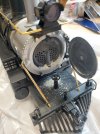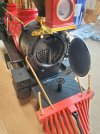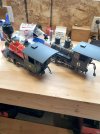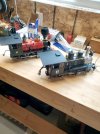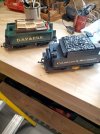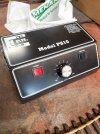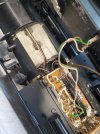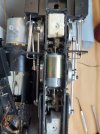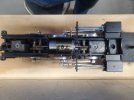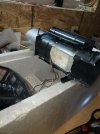Hello, I just inherited two LGB engines from a family member. Specifically, 2018D and 2019S. They both look in good shape, but haven't been run in years. Here is my dilemma; I began to look at lubricating the wheels, but as I did I kept finding a light grey/green powder/grit substance falling out of the engine, when I opened up the front of the smokebox door more of the of the substance came out. Please see attached pics. What is it, and how bad of a problem is this?!? I have never worked with G scale before and I'm definitely a newbie!! Many thanks for advice and thoughts.
You are using an out of date browser. It may not display this or other websites correctly.
You should upgrade or use an alternative browser.
You should upgrade or use an alternative browser.
Need help with two LGB Engines
- Thread starter mpricedhc
- Start date
Oh that is a wonder, looks like washing powder but I cant imagine how it would be. I would just try to het it all out, including trying to get the boiler apart to ensure that you can tap any out that may be inside. If similar sound inside the gearboz a full strip down a d clean to put fresh lubrication inside may be required. If you are new to LGB and have digital photo accessibility take pictures as you pull apart plus put screws into a secure location for reassembly. Sorry teaching how to suck eggs, but a surprising amount forget those two basis so I always feel happier to state them rather than not. You may find the LGb breakdown diagrams helpful, found in this link.Hello, I just inherited two LGB engines from a family member. Specifically, 2018D and 2019S. They both look in good shape, but haven't been run in years. Here is my dilemma; I began to look at lubricating the wheels, but as I did I kept finding a light grey/green powder/grit substance falling out of the engine, when I opened up the front of the smokebox door more of the of the substance came out. Please see attached pics. What is it, and how bad of a problem is this?!? I have never worked with G scale before and I'm definitely a newbie!! Many thanks for advice and thoughts.
JimmyB
Now retired - trains and fishing
It certainly looks like the by-products of corrosion, of some sort?
What is the climate like, where you are? - If you have heat, and high humidity, it might be from the metal weights in the loco(s), but I think I would agree with Paul M, that it looks like the salts from battery corrosion..
Look for additional wires (probably from the rear) and / or extra switches and possibly a charging socket, somewhere on the loco.
Lots of pictures, from different angles, would help us to help you identify these.
Did they come with any sort of handset / controller, at all?
PhilP.
What is the climate like, where you are? - If you have heat, and high humidity, it might be from the metal weights in the loco(s), but I think I would agree with Paul M, that it looks like the salts from battery corrosion..
Look for additional wires (probably from the rear) and / or extra switches and possibly a charging socket, somewhere on the loco.
Lots of pictures, from different angles, would help us to help you identify these.
Did they come with any sort of handset / controller, at all?
PhilP.
Ah never thought of that one, getting inside will certainly help.It certainly looks like the by-products of corrosion, of some sort?
What is the climate like, where you are? - If you have heat, and high humidity, it might be from the metal weights in the loco(s), but I think I would agree with Paul M, that it looks like the salts from battery corrosion..
Look for additional wires (probably from the rear) and / or extra switches and possibly a charging socket, somewhere on the loco.
Lots of pictures, from different angles, would help us to help you identify these.
Did they come with any sort of handset / controller, at all?
PhilP.
Thank you all for your responses! Here is what I know about the engines. They were originally in California, USA, close to the coast, but never used outsiAde, only around a Christmas tree? And then sat on a shelf as display most of time. From there they were moved to Texas, USA where they sat in storage in their original boxes (humid there yes), then in May, I received them and moved them to my home in South Dakota, USA (dry climate). I talked to my Uncle (he is in his 90s) who I received these from and he wondered if it might be residue from smoke cartridges. But I think he may be confused, because I thought oil was used to create the smoke. As far as I can tell both engines are original and no conversions. I did run them for about 2 feet (.6 meter) just to see if they worked, and they did using the controller shown. I didn't try to run them much, because I wanted to lubricate them first, and that is when I discover this powdery like stuff falling out of them. I will attempt to take them apart and see what evil lurks inside. And yes Dunnyrail, your advice is spot on, I will take many pictures and organize my parts during disassembly! I am fairly mechanical, but I am still a tad uneasy about taking these apart! I am attaching more photos, if anyone should see something that may help me, advice is always appreciated. Again many thanks to all.
Mike
Mike
Attachments
Well I got my engine open and as someone mentioned it appears as though the lead weights have oxidized. Can anyone give me suggestions advice to get this cleaned up? I started with the chassis but I’m not sure what I am doing. I was thinking I need to remove the gears, but they don’t seem to easily want to be removed and I am afraid of breaking something. Any help would be greatly appreciated!
Attachments
GAP
G Scale Model Trains, 1:1 Sugar Cane Trains
To clean them up, get them out use a small wire brush to remove the corrosion the once you have bright metal apply a thin smear of light oil.
You could always use a PCB coating spray to prevent moisture getting back to them.
Experience living above the tropic in Northern Australia .
Don't think you have to go near the gears to get the weights
These exploded diagrams may give some guidance on how to get them out.
You could always use a PCB coating spray to prevent moisture getting back to them.
Experience living above the tropic in Northern Australia .
Don't think you have to go near the gears to get the weights
These exploded diagrams may give some guidance on how to get them out.
Ok, but unfortunately the white powder/granules are everywhere, including in the gears. I'm not even certain how to attack the boiler area yet, and circuit board.To clean them up, get them out use a small wire brush to remove the corrosion the once you have bright metal apply a thin smear of light oil.
You could always use a PCB coating spray to prevent moisture getting back to them.
Experience living above the tropic in Northern Australia .
Don't think you have to go near the gears to get the weights
These exploded diagrams may give some guidance on how to get them out.
Getting new weights may be an issue. I think cleaning up asTry using a small computer keyboard vacuum. Looking at the state of the weights, it may be easier to replace them
As for the gears, I think they should come out via the bottom plate with the wheels. Do not be tempted to pull the wheels off the axles unless they are older type with screws. Similarly do not be tempted to take any gears of any axles.
Cleaning up old oil using cotton buds be sure to remove any cotton. Brushing off dust after that and perhaps another go with the cotton buds then regrease with LGB 51020 or suitable equivalent. Do not overdo this, a splidge on the end of a screwdriver on each gear will be enough. When running it will distribute itself over the rest of each gear.
DON'T just start taking the whole motor-block apart!
Especially if this is your first time. - Remember to take lots of pictures.
Clean up the weights, and anything else you can, at the top-end first.
Put that back together, before you turn the loco over, and open up the bottom.
Once you take the bottom plate off, you can start to remove the axkes/wheels. - You may have to remove the rods from the wheels. Don't mix the wheelsets up, and note where there are washers, and which screw is which.
Note the positions of the metal strips providing connections along the various contacts. - They are not necessary symmetrical.
PhilP.
Especially if this is your first time. - Remember to take lots of pictures.
Clean up the weights, and anything else you can, at the top-end first.
Put that back together, before you turn the loco over, and open up the bottom.
Once you take the bottom plate off, you can start to remove the axkes/wheels. - You may have to remove the rods from the wheels. Don't mix the wheelsets up, and note where there are washers, and which screw is which.
Note the positions of the metal strips providing connections along the various contacts. - They are not necessary symmetrical.
PhilP.
Many thanks to all of you! I have now completed cleaning and lubricating the motor assembly. However, the worst appears to be in the boiler section where the larger lead weight is and cicuit board. If anyone has suggestions on how to remove and clean this I would really appreciate the advice! Thanks!
Mike
Mike
Thanks, the old grease was actually hard! I tried not to add too much grease, but....Getting new weights may be an issue. I think cleaning up asGAP suggested is the right way to go, if stored say indoors rather than a damp hot/cold/sweaty shed they should not go that way again.
As for the gears, I think they should come out via the bottom plate with the wheels. Do not be tempted to pull the wheels off the axles unless they are older type with screws. Similarly do not be tempted to take any gears of any axles.
Cleaning up old oil using cotton buds be sure to remove any cotton. Brushing off dust after that and perhaps another go with the cotton buds then regrease with LGB 51020 or suitable equivalent. Do not overdo this, a splidge on the end of a screwdriver on each gear will be enough. When running it will distribute itself over the rest of each gear.
stevedenver
Registered
Smoke fluid is indeed used in these locos.
Wow that is severe corrosion. Fwiw, if they don’t clean up, there are replacements. On eBay they are usually pretty expensive. Youll have to check retailers that carry parts. Only trains, train-li, ajc kids, etc.
I know this sounds nuts, but since you havent the experience to do a tear down,
You can use light steel wool on the weight and/or shell. Pressure accordingly. Do not get the steel wool near the motor and gears.
You can use dish soap and a toothbrush, everywhere, thoroughly rinse, dry..thoroughly. Very.
You can use a hair dryer on cool. Drying is important. Very.
If you have battery corrosion, this can be cleaned with vinegar, gentle scraping, steel wool.
The re-lube with plastic compatible grease or oil.
Wash your hands thoroughly afterwards.
Tip, never force reassembly-everything fits once you figure it out, and, gently back thread any screws you remove before tightening to avoid stripping the plastic.
I have done this. Even the analogue sound board can get wet, but it must be dried. In the 2019s, i believe it is in the tendr. There is no issue with the 2018 and wetness. To make sure they are dry, You may have to leave the locos open with air circulation for a day or more.
Lgb grease is great. If you don’t have any, labelle teflon grease is great too. Heavy oil, not so much for gears.
Your locos arent complicated. If you choose to dive in, a couple of thoughts.
Leave enough time to complete the job. This way you’ll remember what went where.
Work over a towel.
Never force anything. Lgb fits beautifully, but sometimes it take a bit to figure things out.
Wheels must be requartered precisely.
If you search my posts, i gave a detailed step by step on disassembly, lubrication.
Thinking 2-3 years back. Title had either 2018, 2028, or mogul as i recall. Might have been archived by now.
Best of luck.
Wow that is severe corrosion. Fwiw, if they don’t clean up, there are replacements. On eBay they are usually pretty expensive. Youll have to check retailers that carry parts. Only trains, train-li, ajc kids, etc.
I know this sounds nuts, but since you havent the experience to do a tear down,
You can use light steel wool on the weight and/or shell. Pressure accordingly. Do not get the steel wool near the motor and gears.
You can use dish soap and a toothbrush, everywhere, thoroughly rinse, dry..thoroughly. Very.
You can use a hair dryer on cool. Drying is important. Very.
If you have battery corrosion, this can be cleaned with vinegar, gentle scraping, steel wool.
The re-lube with plastic compatible grease or oil.
Wash your hands thoroughly afterwards.
Tip, never force reassembly-everything fits once you figure it out, and, gently back thread any screws you remove before tightening to avoid stripping the plastic.
I have done this. Even the analogue sound board can get wet, but it must be dried. In the 2019s, i believe it is in the tendr. There is no issue with the 2018 and wetness. To make sure they are dry, You may have to leave the locos open with air circulation for a day or more.
Lgb grease is great. If you don’t have any, labelle teflon grease is great too. Heavy oil, not so much for gears.
Your locos arent complicated. If you choose to dive in, a couple of thoughts.
Leave enough time to complete the job. This way you’ll remember what went where.
Work over a towel.
Never force anything. Lgb fits beautifully, but sometimes it take a bit to figure things out.
Wheels must be requartered precisely.
If you search my posts, i gave a detailed step by step on disassembly, lubrication.
Thinking 2-3 years back. Title had either 2018, 2028, or mogul as i recall. Might have been archived by now.
Best of luck.
Last edited:
Wow, thanks everyone!! I got the lower chassis cleaned and lubed and assembled see pic. I think I did ok. The major problem though is in the boiler and it's weight. I don't see how to get it out, and I am afraid if I don't , it will just ruin what I just got cleaned up. I attached a pic of the large weight in boiler. I have the screws out, but by looking at the diagram that people have been kind enough to share, it will not slide out toward the cab and the front, smokebox? seems very attached and no way to remove. It was suggested to soak in vinegar to help remove oxidation from the lead. If I place the whole boiler in a vinegar solution, will that ruin the plastic body and wiring? As always, many thanks for any advice here.
Mike
Mike

